Phosphorus Recovery and Reuse Options
VerifiedAdded on 2020/07/23
|14
|3610
|96
AI Summary
This assignment delves into the world of phosphorus recovery and reuse options in the context of agri-food systems. It presents a collection of articles and papers on various aspects of sustainability, including food security, nutrition transition, and value chain approach. The documents cover topics such as mycotoxin contamination, trade and market access, sugar restriction, life cycle assessment, and pest-associated risks in stored food and feed products.
Contribute Materials
Your contribution can guide someone’s learning journey. Share your
documents today.
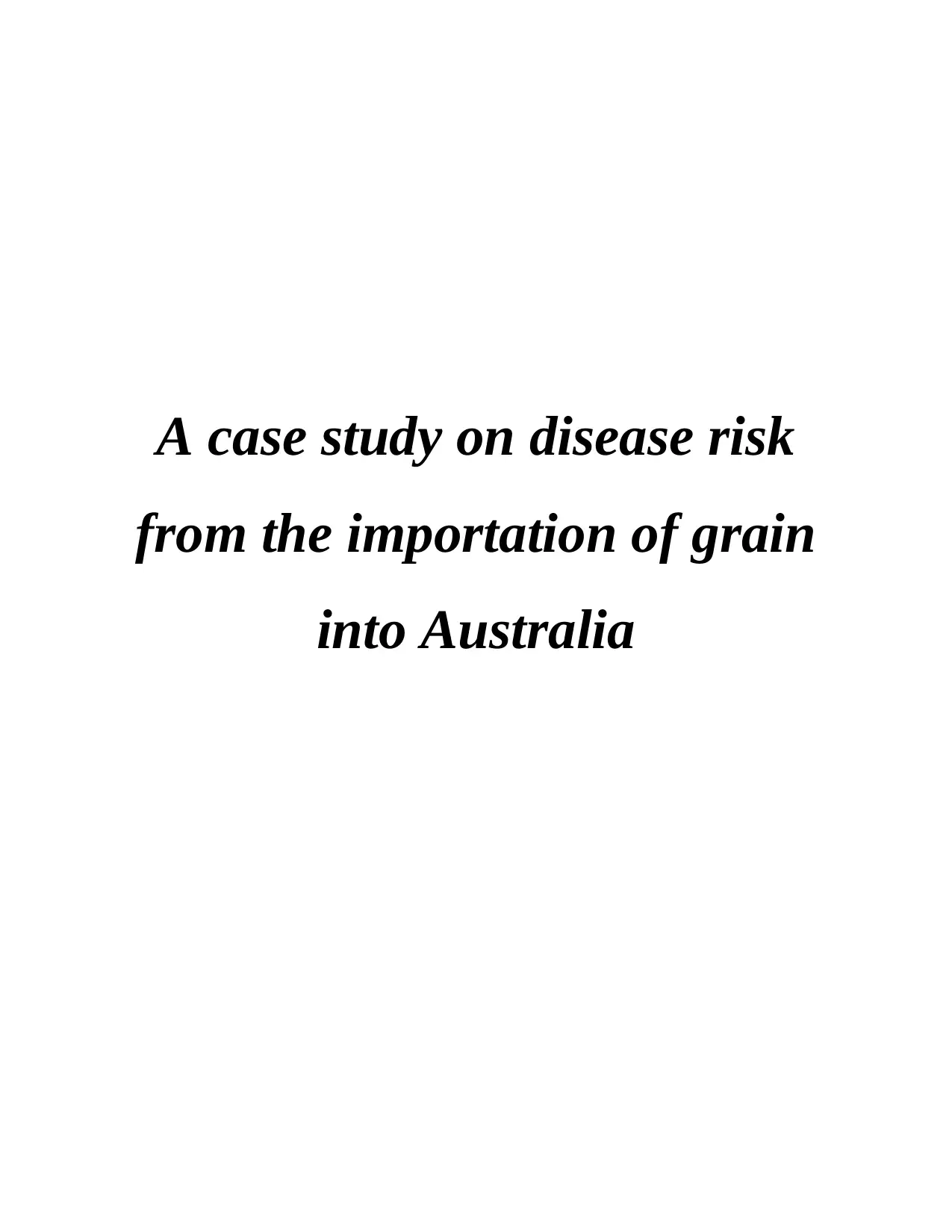
A case study on disease risk
from the importation of grain
into Australia
from the importation of grain
into Australia
Secure Best Marks with AI Grader
Need help grading? Try our AI Grader for instant feedback on your assignments.
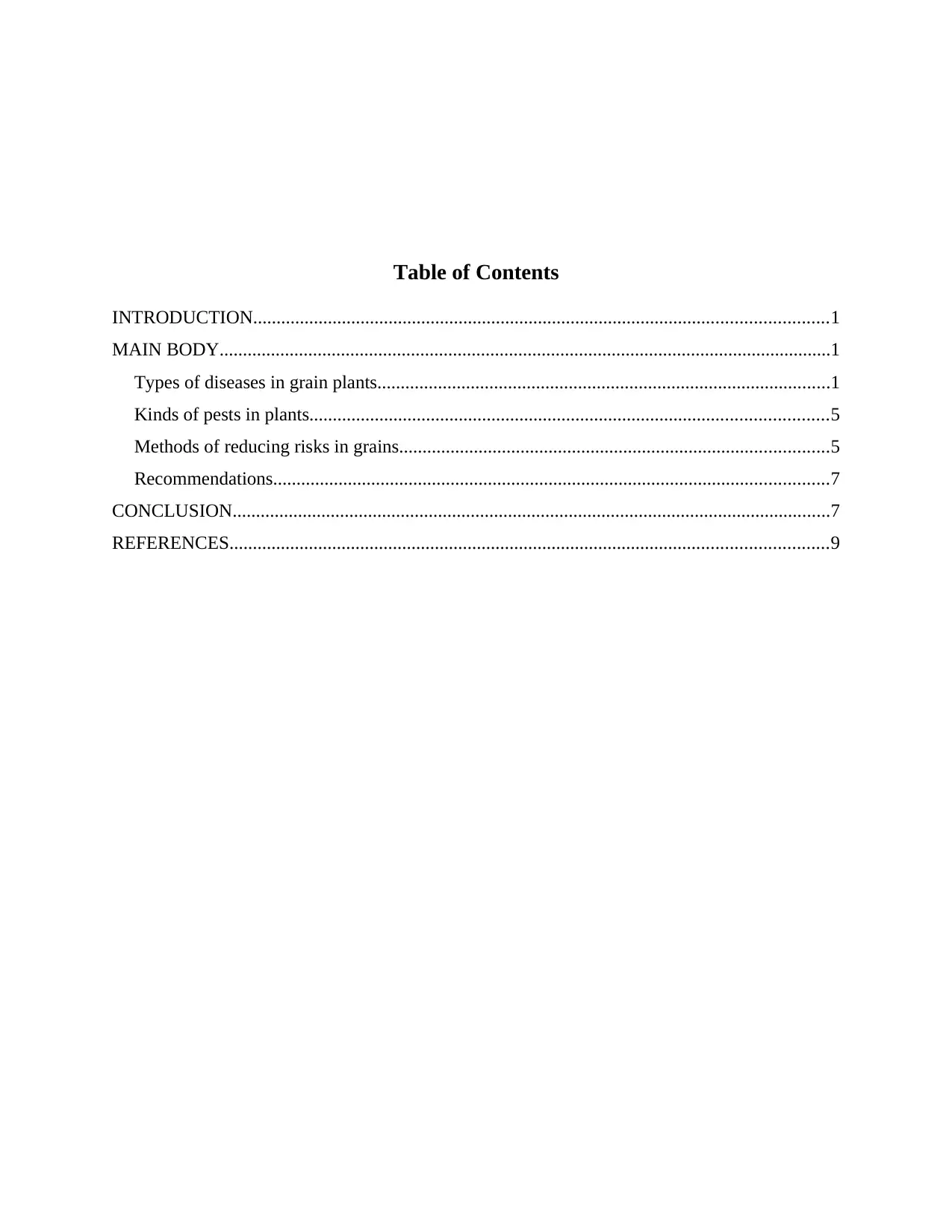
Table of Contents
INTRODUCTION...........................................................................................................................1
MAIN BODY...................................................................................................................................1
Types of diseases in grain plants.................................................................................................1
Kinds of pests in plants...............................................................................................................5
Methods of reducing risks in grains............................................................................................5
Recommendations.......................................................................................................................7
CONCLUSION................................................................................................................................7
REFERENCES................................................................................................................................9
INTRODUCTION...........................................................................................................................1
MAIN BODY...................................................................................................................................1
Types of diseases in grain plants.................................................................................................1
Kinds of pests in plants...............................................................................................................5
Methods of reducing risks in grains............................................................................................5
Recommendations.......................................................................................................................7
CONCLUSION................................................................................................................................7
REFERENCES................................................................................................................................9
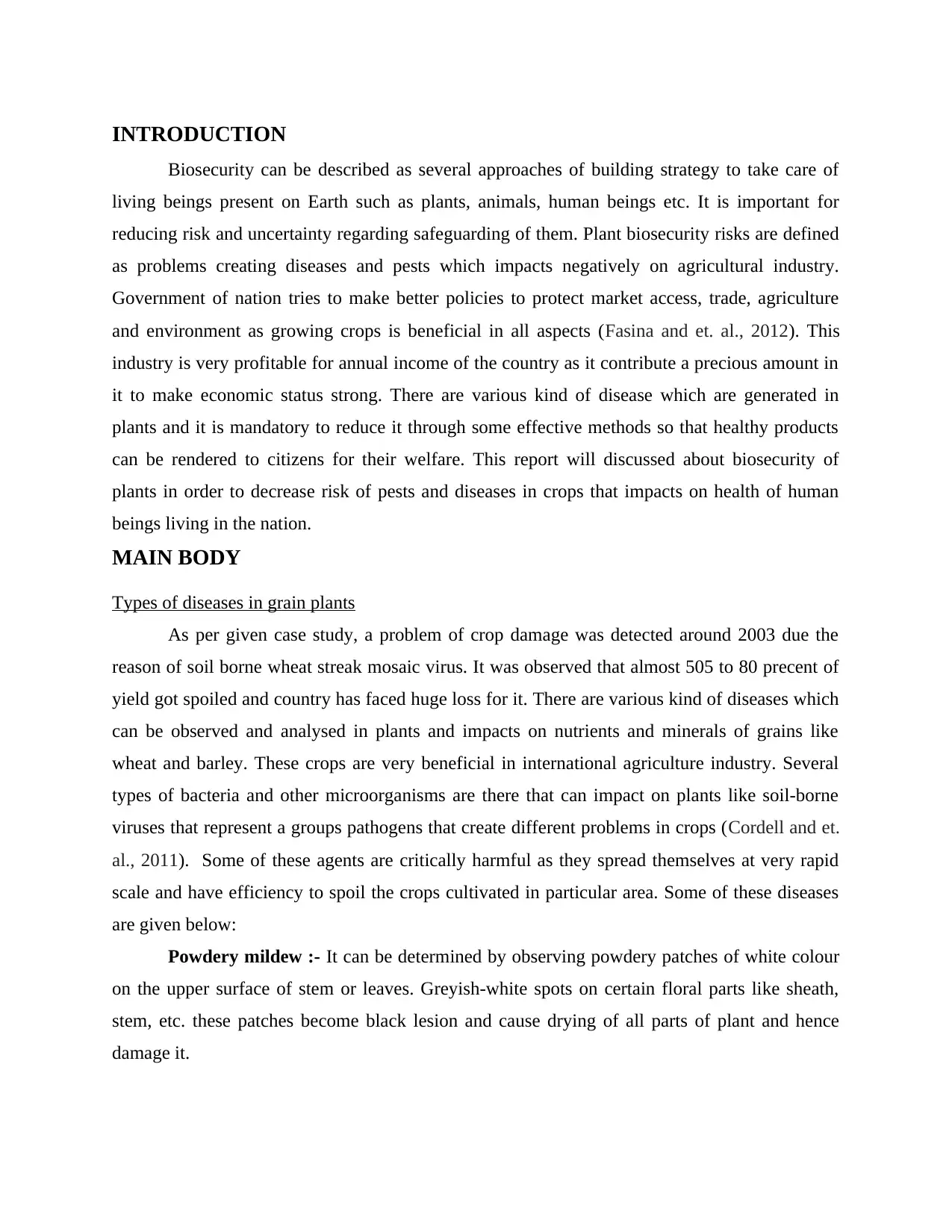
INTRODUCTION
Biosecurity can be described as several approaches of building strategy to take care of
living beings present on Earth such as plants, animals, human beings etc. It is important for
reducing risk and uncertainty regarding safeguarding of them. Plant biosecurity risks are defined
as problems creating diseases and pests which impacts negatively on agricultural industry.
Government of nation tries to make better policies to protect market access, trade, agriculture
and environment as growing crops is beneficial in all aspects (Fasina and et. al., 2012). This
industry is very profitable for annual income of the country as it contribute a precious amount in
it to make economic status strong. There are various kind of disease which are generated in
plants and it is mandatory to reduce it through some effective methods so that healthy products
can be rendered to citizens for their welfare. This report will discussed about biosecurity of
plants in order to decrease risk of pests and diseases in crops that impacts on health of human
beings living in the nation.
MAIN BODY
Types of diseases in grain plants
As per given case study, a problem of crop damage was detected around 2003 due the
reason of soil borne wheat streak mosaic virus. It was observed that almost 505 to 80 precent of
yield got spoiled and country has faced huge loss for it. There are various kind of diseases which
can be observed and analysed in plants and impacts on nutrients and minerals of grains like
wheat and barley. These crops are very beneficial in international agriculture industry. Several
types of bacteria and other microorganisms are there that can impact on plants like soil-borne
viruses that represent a groups pathogens that create different problems in crops (Cordell and et.
al., 2011). Some of these agents are critically harmful as they spread themselves at very rapid
scale and have efficiency to spoil the crops cultivated in particular area. Some of these diseases
are given below:
Powdery mildew :- It can be determined by observing powdery patches of white colour
on the upper surface of stem or leaves. Greyish-white spots on certain floral parts like sheath,
stem, etc. these patches become black lesion and cause drying of all parts of plant and hence
damage it.
Biosecurity can be described as several approaches of building strategy to take care of
living beings present on Earth such as plants, animals, human beings etc. It is important for
reducing risk and uncertainty regarding safeguarding of them. Plant biosecurity risks are defined
as problems creating diseases and pests which impacts negatively on agricultural industry.
Government of nation tries to make better policies to protect market access, trade, agriculture
and environment as growing crops is beneficial in all aspects (Fasina and et. al., 2012). This
industry is very profitable for annual income of the country as it contribute a precious amount in
it to make economic status strong. There are various kind of disease which are generated in
plants and it is mandatory to reduce it through some effective methods so that healthy products
can be rendered to citizens for their welfare. This report will discussed about biosecurity of
plants in order to decrease risk of pests and diseases in crops that impacts on health of human
beings living in the nation.
MAIN BODY
Types of diseases in grain plants
As per given case study, a problem of crop damage was detected around 2003 due the
reason of soil borne wheat streak mosaic virus. It was observed that almost 505 to 80 precent of
yield got spoiled and country has faced huge loss for it. There are various kind of diseases which
can be observed and analysed in plants and impacts on nutrients and minerals of grains like
wheat and barley. These crops are very beneficial in international agriculture industry. Several
types of bacteria and other microorganisms are there that can impact on plants like soil-borne
viruses that represent a groups pathogens that create different problems in crops (Cordell and et.
al., 2011). Some of these agents are critically harmful as they spread themselves at very rapid
scale and have efficiency to spoil the crops cultivated in particular area. Some of these diseases
are given below:
Powdery mildew :- It can be determined by observing powdery patches of white colour
on the upper surface of stem or leaves. Greyish-white spots on certain floral parts like sheath,
stem, etc. these patches become black lesion and cause drying of all parts of plant and hence
damage it.
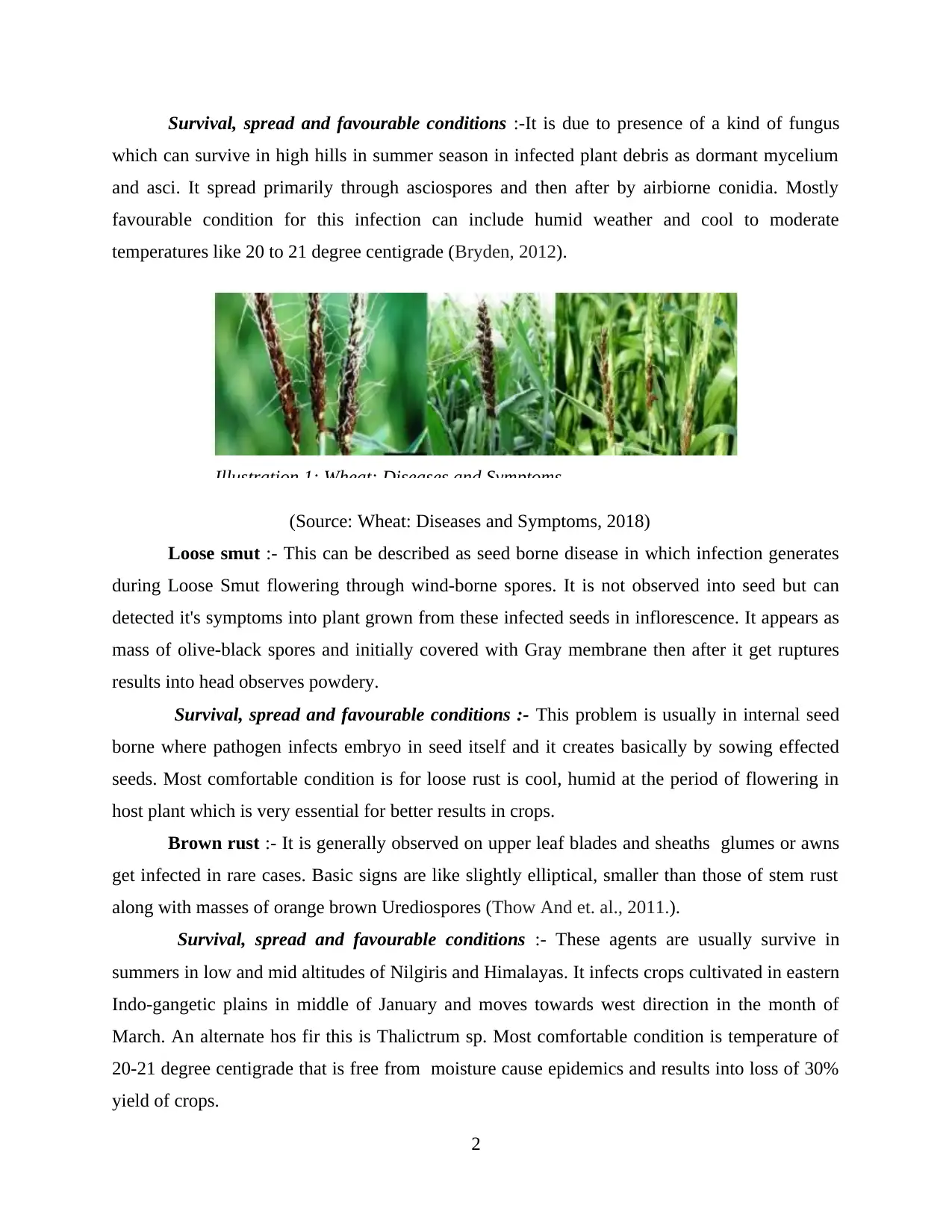
Survival, spread and favourable conditions :-It is due to presence of a kind of fungus
which can survive in high hills in summer season in infected plant debris as dormant mycelium
and asci. It spread primarily through asciospores and then after by airbiorne conidia. Mostly
favourable condition for this infection can include humid weather and cool to moderate
temperatures like 20 to 21 degree centigrade (Bryden, 2012).
(Source: Wheat: Diseases and Symptoms, 2018)
Loose smut :- This can be described as seed borne disease in which infection generates
during Loose Smut flowering through wind-borne spores. It is not observed into seed but can
detected it's symptoms into plant grown from these infected seeds in inflorescence. It appears as
mass of olive-black spores and initially covered with Gray membrane then after it get ruptures
results into head observes powdery.
Survival, spread and favourable conditions :- This problem is usually in internal seed
borne where pathogen infects embryo in seed itself and it creates basically by sowing effected
seeds. Most comfortable condition is for loose rust is cool, humid at the period of flowering in
host plant which is very essential for better results in crops.
Brown rust :- It is generally observed on upper leaf blades and sheaths glumes or awns
get infected in rare cases. Basic signs are like slightly elliptical, smaller than those of stem rust
along with masses of orange brown Urediospores (Thow And et. al., 2011.).
Survival, spread and favourable conditions :- These agents are usually survive in
summers in low and mid altitudes of Nilgiris and Himalayas. It infects crops cultivated in eastern
Indo-gangetic plains in middle of January and moves towards west direction in the month of
March. An alternate hos fir this is Thalictrum sp. Most comfortable condition is temperature of
20-21 degree centigrade that is free from moisture cause epidemics and results into loss of 30%
yield of crops.
2
Illustration 1: Wheat: Diseases and Symptoms
which can survive in high hills in summer season in infected plant debris as dormant mycelium
and asci. It spread primarily through asciospores and then after by airbiorne conidia. Mostly
favourable condition for this infection can include humid weather and cool to moderate
temperatures like 20 to 21 degree centigrade (Bryden, 2012).
(Source: Wheat: Diseases and Symptoms, 2018)
Loose smut :- This can be described as seed borne disease in which infection generates
during Loose Smut flowering through wind-borne spores. It is not observed into seed but can
detected it's symptoms into plant grown from these infected seeds in inflorescence. It appears as
mass of olive-black spores and initially covered with Gray membrane then after it get ruptures
results into head observes powdery.
Survival, spread and favourable conditions :- This problem is usually in internal seed
borne where pathogen infects embryo in seed itself and it creates basically by sowing effected
seeds. Most comfortable condition is for loose rust is cool, humid at the period of flowering in
host plant which is very essential for better results in crops.
Brown rust :- It is generally observed on upper leaf blades and sheaths glumes or awns
get infected in rare cases. Basic signs are like slightly elliptical, smaller than those of stem rust
along with masses of orange brown Urediospores (Thow And et. al., 2011.).
Survival, spread and favourable conditions :- These agents are usually survive in
summers in low and mid altitudes of Nilgiris and Himalayas. It infects crops cultivated in eastern
Indo-gangetic plains in middle of January and moves towards west direction in the month of
March. An alternate hos fir this is Thalictrum sp. Most comfortable condition is temperature of
20-21 degree centigrade that is free from moisture cause epidemics and results into loss of 30%
yield of crops.
2
Illustration 1: Wheat: Diseases and Symptoms
Secure Best Marks with AI Grader
Need help grading? Try our AI Grader for instant feedback on your assignments.
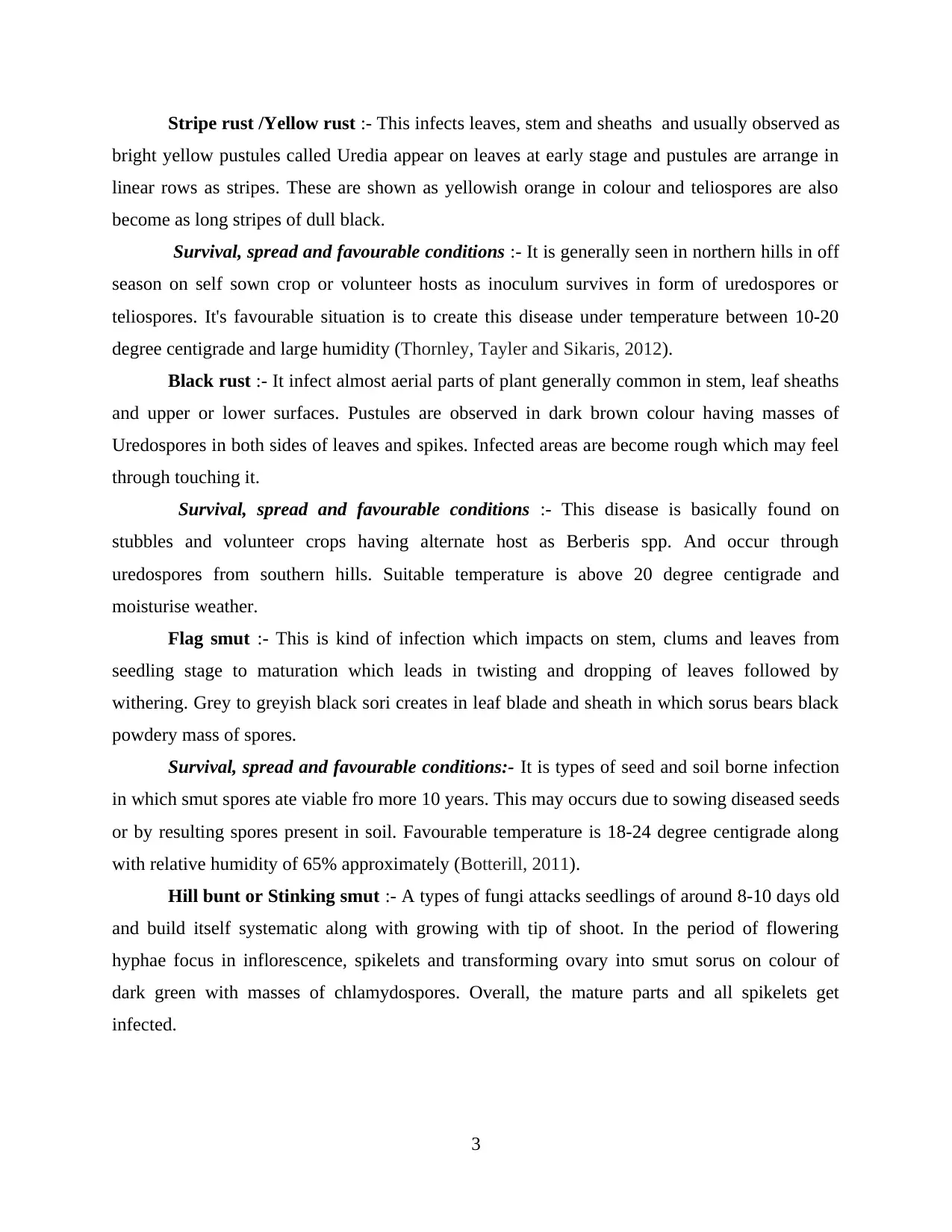
Stripe rust /Yellow rust :- This infects leaves, stem and sheaths and usually observed as
bright yellow pustules called Uredia appear on leaves at early stage and pustules are arrange in
linear rows as stripes. These are shown as yellowish orange in colour and teliospores are also
become as long stripes of dull black.
Survival, spread and favourable conditions :- It is generally seen in northern hills in off
season on self sown crop or volunteer hosts as inoculum survives in form of uredospores or
teliospores. It's favourable situation is to create this disease under temperature between 10-20
degree centigrade and large humidity (Thornley, Tayler and Sikaris, 2012).
Black rust :- It infect almost aerial parts of plant generally common in stem, leaf sheaths
and upper or lower surfaces. Pustules are observed in dark brown colour having masses of
Uredospores in both sides of leaves and spikes. Infected areas are become rough which may feel
through touching it.
Survival, spread and favourable conditions :- This disease is basically found on
stubbles and volunteer crops having alternate host as Berberis spp. And occur through
uredospores from southern hills. Suitable temperature is above 20 degree centigrade and
moisturise weather.
Flag smut :- This is kind of infection which impacts on stem, clums and leaves from
seedling stage to maturation which leads in twisting and dropping of leaves followed by
withering. Grey to greyish black sori creates in leaf blade and sheath in which sorus bears black
powdery mass of spores.
Survival, spread and favourable conditions:- It is types of seed and soil borne infection
in which smut spores ate viable fro more 10 years. This may occurs due to sowing diseased seeds
or by resulting spores present in soil. Favourable temperature is 18-24 degree centigrade along
with relative humidity of 65% approximately (Botterill, 2011).
Hill bunt or Stinking smut :- A types of fungi attacks seedlings of around 8-10 days old
and build itself systematic along with growing with tip of shoot. In the period of flowering
hyphae focus in inflorescence, spikelets and transforming ovary into smut sorus on colour of
dark green with masses of chlamydospores. Overall, the mature parts and all spikelets get
infected.
3
bright yellow pustules called Uredia appear on leaves at early stage and pustules are arrange in
linear rows as stripes. These are shown as yellowish orange in colour and teliospores are also
become as long stripes of dull black.
Survival, spread and favourable conditions :- It is generally seen in northern hills in off
season on self sown crop or volunteer hosts as inoculum survives in form of uredospores or
teliospores. It's favourable situation is to create this disease under temperature between 10-20
degree centigrade and large humidity (Thornley, Tayler and Sikaris, 2012).
Black rust :- It infect almost aerial parts of plant generally common in stem, leaf sheaths
and upper or lower surfaces. Pustules are observed in dark brown colour having masses of
Uredospores in both sides of leaves and spikes. Infected areas are become rough which may feel
through touching it.
Survival, spread and favourable conditions :- This disease is basically found on
stubbles and volunteer crops having alternate host as Berberis spp. And occur through
uredospores from southern hills. Suitable temperature is above 20 degree centigrade and
moisturise weather.
Flag smut :- This is kind of infection which impacts on stem, clums and leaves from
seedling stage to maturation which leads in twisting and dropping of leaves followed by
withering. Grey to greyish black sori creates in leaf blade and sheath in which sorus bears black
powdery mass of spores.
Survival, spread and favourable conditions:- It is types of seed and soil borne infection
in which smut spores ate viable fro more 10 years. This may occurs due to sowing diseased seeds
or by resulting spores present in soil. Favourable temperature is 18-24 degree centigrade along
with relative humidity of 65% approximately (Botterill, 2011).
Hill bunt or Stinking smut :- A types of fungi attacks seedlings of around 8-10 days old
and build itself systematic along with growing with tip of shoot. In the period of flowering
hyphae focus in inflorescence, spikelets and transforming ovary into smut sorus on colour of
dark green with masses of chlamydospores. Overall, the mature parts and all spikelets get
infected.
3
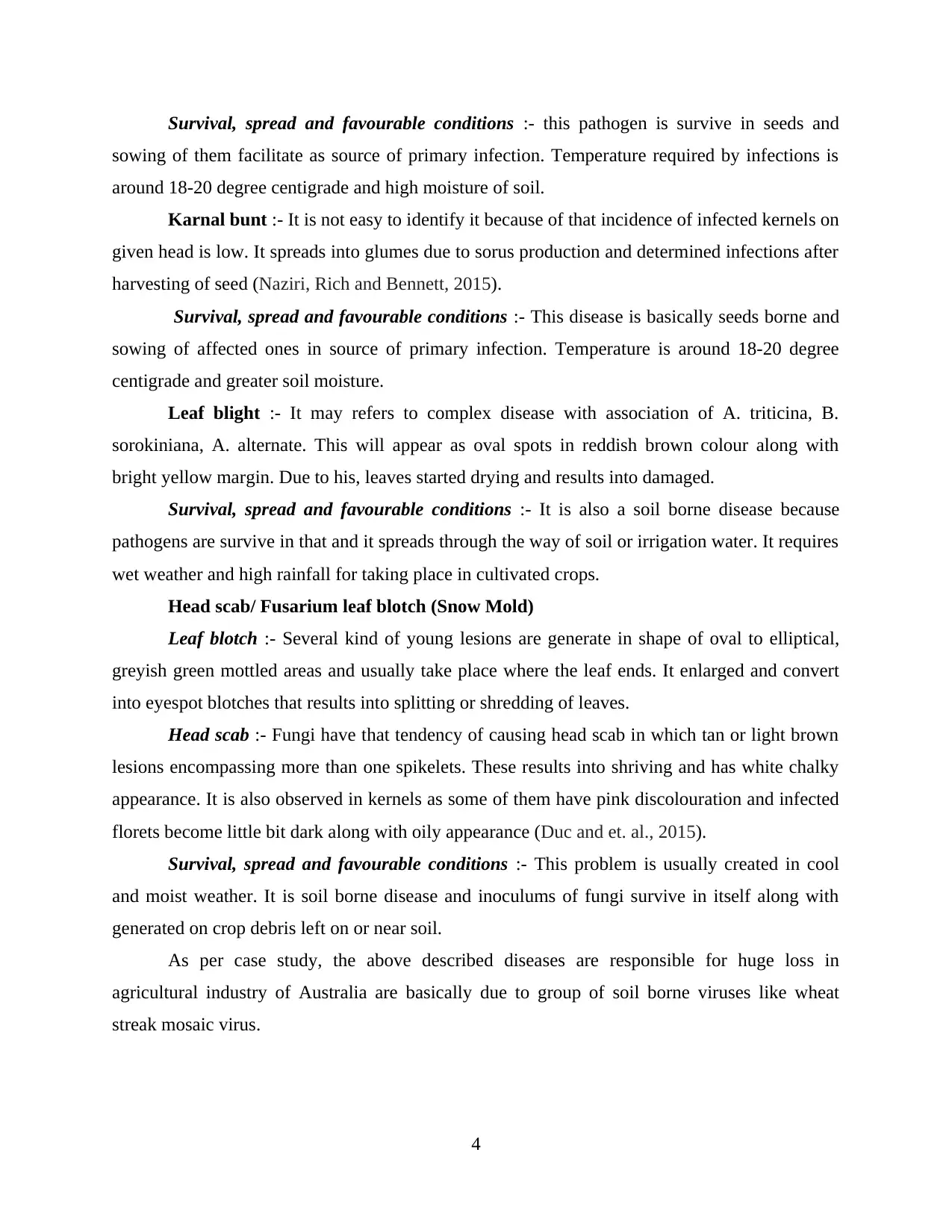
Survival, spread and favourable conditions :- this pathogen is survive in seeds and
sowing of them facilitate as source of primary infection. Temperature required by infections is
around 18-20 degree centigrade and high moisture of soil.
Karnal bunt :- It is not easy to identify it because of that incidence of infected kernels on
given head is low. It spreads into glumes due to sorus production and determined infections after
harvesting of seed (Naziri, Rich and Bennett, 2015).
Survival, spread and favourable conditions :- This disease is basically seeds borne and
sowing of affected ones in source of primary infection. Temperature is around 18-20 degree
centigrade and greater soil moisture.
Leaf blight :- It may refers to complex disease with association of A. triticina, B.
sorokiniana, A. alternate. This will appear as oval spots in reddish brown colour along with
bright yellow margin. Due to his, leaves started drying and results into damaged.
Survival, spread and favourable conditions :- It is also a soil borne disease because
pathogens are survive in that and it spreads through the way of soil or irrigation water. It requires
wet weather and high rainfall for taking place in cultivated crops.
Head scab/ Fusarium leaf blotch (Snow Mold)
Leaf blotch :- Several kind of young lesions are generate in shape of oval to elliptical,
greyish green mottled areas and usually take place where the leaf ends. It enlarged and convert
into eyespot blotches that results into splitting or shredding of leaves.
Head scab :- Fungi have that tendency of causing head scab in which tan or light brown
lesions encompassing more than one spikelets. These results into shriving and has white chalky
appearance. It is also observed in kernels as some of them have pink discolouration and infected
florets become little bit dark along with oily appearance (Duc and et. al., 2015).
Survival, spread and favourable conditions :- This problem is usually created in cool
and moist weather. It is soil borne disease and inoculums of fungi survive in itself along with
generated on crop debris left on or near soil.
As per case study, the above described diseases are responsible for huge loss in
agricultural industry of Australia are basically due to group of soil borne viruses like wheat
streak mosaic virus.
4
sowing of them facilitate as source of primary infection. Temperature required by infections is
around 18-20 degree centigrade and high moisture of soil.
Karnal bunt :- It is not easy to identify it because of that incidence of infected kernels on
given head is low. It spreads into glumes due to sorus production and determined infections after
harvesting of seed (Naziri, Rich and Bennett, 2015).
Survival, spread and favourable conditions :- This disease is basically seeds borne and
sowing of affected ones in source of primary infection. Temperature is around 18-20 degree
centigrade and greater soil moisture.
Leaf blight :- It may refers to complex disease with association of A. triticina, B.
sorokiniana, A. alternate. This will appear as oval spots in reddish brown colour along with
bright yellow margin. Due to his, leaves started drying and results into damaged.
Survival, spread and favourable conditions :- It is also a soil borne disease because
pathogens are survive in that and it spreads through the way of soil or irrigation water. It requires
wet weather and high rainfall for taking place in cultivated crops.
Head scab/ Fusarium leaf blotch (Snow Mold)
Leaf blotch :- Several kind of young lesions are generate in shape of oval to elliptical,
greyish green mottled areas and usually take place where the leaf ends. It enlarged and convert
into eyespot blotches that results into splitting or shredding of leaves.
Head scab :- Fungi have that tendency of causing head scab in which tan or light brown
lesions encompassing more than one spikelets. These results into shriving and has white chalky
appearance. It is also observed in kernels as some of them have pink discolouration and infected
florets become little bit dark along with oily appearance (Duc and et. al., 2015).
Survival, spread and favourable conditions :- This problem is usually created in cool
and moist weather. It is soil borne disease and inoculums of fungi survive in itself along with
generated on crop debris left on or near soil.
As per case study, the above described diseases are responsible for huge loss in
agricultural industry of Australia are basically due to group of soil borne viruses like wheat
streak mosaic virus.
4
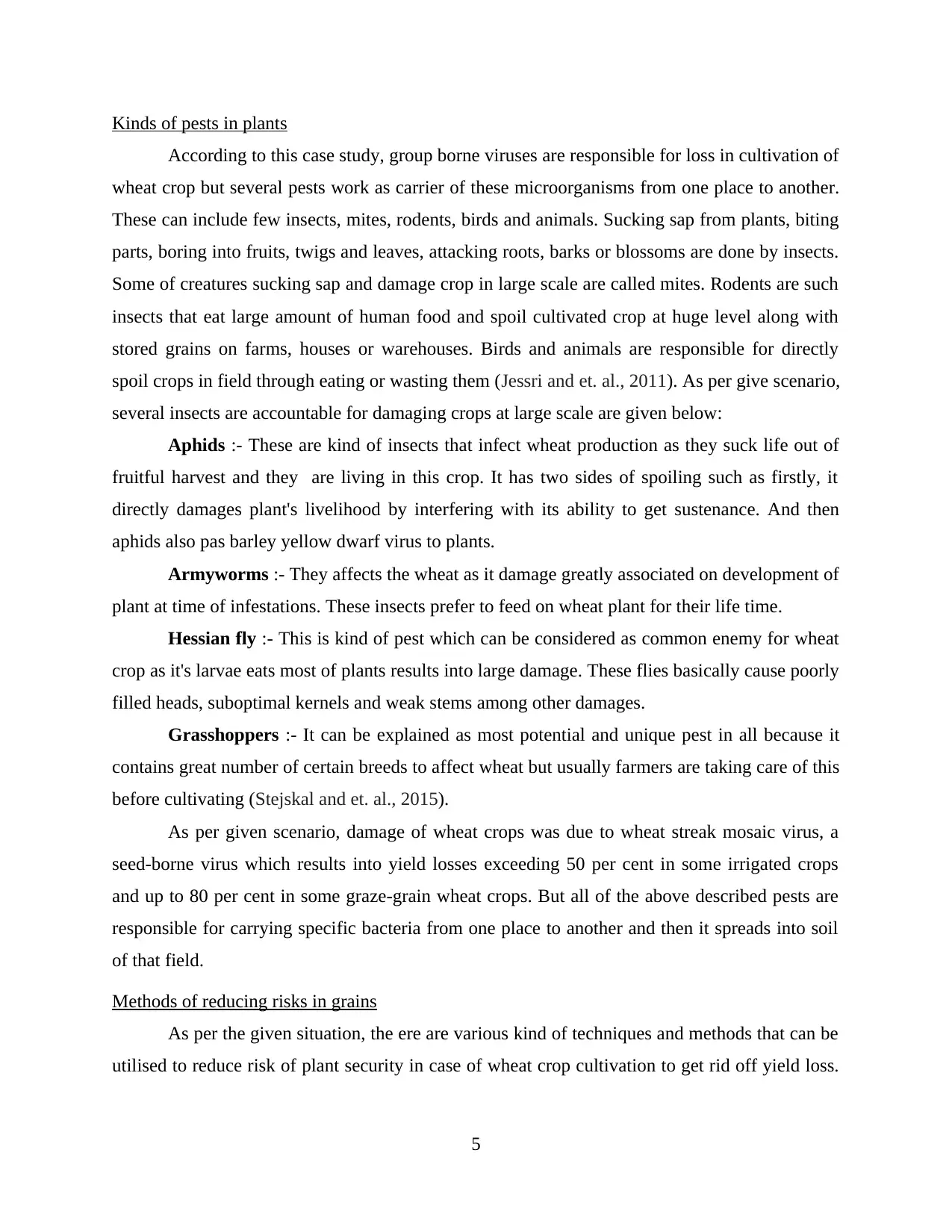
Kinds of pests in plants
According to this case study, group borne viruses are responsible for loss in cultivation of
wheat crop but several pests work as carrier of these microorganisms from one place to another.
These can include few insects, mites, rodents, birds and animals. Sucking sap from plants, biting
parts, boring into fruits, twigs and leaves, attacking roots, barks or blossoms are done by insects.
Some of creatures sucking sap and damage crop in large scale are called mites. Rodents are such
insects that eat large amount of human food and spoil cultivated crop at huge level along with
stored grains on farms, houses or warehouses. Birds and animals are responsible for directly
spoil crops in field through eating or wasting them (Jessri and et. al., 2011). As per give scenario,
several insects are accountable for damaging crops at large scale are given below:
Aphids :- These are kind of insects that infect wheat production as they suck life out of
fruitful harvest and they are living in this crop. It has two sides of spoiling such as firstly, it
directly damages plant's livelihood by interfering with its ability to get sustenance. And then
aphids also pas barley yellow dwarf virus to plants.
Armyworms :- They affects the wheat as it damage greatly associated on development of
plant at time of infestations. These insects prefer to feed on wheat plant for their life time.
Hessian fly :- This is kind of pest which can be considered as common enemy for wheat
crop as it's larvae eats most of plants results into large damage. These flies basically cause poorly
filled heads, suboptimal kernels and weak stems among other damages.
Grasshoppers :- It can be explained as most potential and unique pest in all because it
contains great number of certain breeds to affect wheat but usually farmers are taking care of this
before cultivating (Stejskal and et. al., 2015).
As per given scenario, damage of wheat crops was due to wheat streak mosaic virus, a
seed-borne virus which results into yield losses exceeding 50 per cent in some irrigated crops
and up to 80 per cent in some graze-grain wheat crops. But all of the above described pests are
responsible for carrying specific bacteria from one place to another and then it spreads into soil
of that field.
Methods of reducing risks in grains
As per the given situation, the ere are various kind of techniques and methods that can be
utilised to reduce risk of plant security in case of wheat crop cultivation to get rid off yield loss.
5
According to this case study, group borne viruses are responsible for loss in cultivation of
wheat crop but several pests work as carrier of these microorganisms from one place to another.
These can include few insects, mites, rodents, birds and animals. Sucking sap from plants, biting
parts, boring into fruits, twigs and leaves, attacking roots, barks or blossoms are done by insects.
Some of creatures sucking sap and damage crop in large scale are called mites. Rodents are such
insects that eat large amount of human food and spoil cultivated crop at huge level along with
stored grains on farms, houses or warehouses. Birds and animals are responsible for directly
spoil crops in field through eating or wasting them (Jessri and et. al., 2011). As per give scenario,
several insects are accountable for damaging crops at large scale are given below:
Aphids :- These are kind of insects that infect wheat production as they suck life out of
fruitful harvest and they are living in this crop. It has two sides of spoiling such as firstly, it
directly damages plant's livelihood by interfering with its ability to get sustenance. And then
aphids also pas barley yellow dwarf virus to plants.
Armyworms :- They affects the wheat as it damage greatly associated on development of
plant at time of infestations. These insects prefer to feed on wheat plant for their life time.
Hessian fly :- This is kind of pest which can be considered as common enemy for wheat
crop as it's larvae eats most of plants results into large damage. These flies basically cause poorly
filled heads, suboptimal kernels and weak stems among other damages.
Grasshoppers :- It can be explained as most potential and unique pest in all because it
contains great number of certain breeds to affect wheat but usually farmers are taking care of this
before cultivating (Stejskal and et. al., 2015).
As per given scenario, damage of wheat crops was due to wheat streak mosaic virus, a
seed-borne virus which results into yield losses exceeding 50 per cent in some irrigated crops
and up to 80 per cent in some graze-grain wheat crops. But all of the above described pests are
responsible for carrying specific bacteria from one place to another and then it spreads into soil
of that field.
Methods of reducing risks in grains
As per the given situation, the ere are various kind of techniques and methods that can be
utilised to reduce risk of plant security in case of wheat crop cultivation to get rid off yield loss.
5
Paraphrase This Document
Need a fresh take? Get an instant paraphrase of this document with our AI Paraphraser

Some of effective as well as efficient procedures along with process of preventing pest connected
with crop are given below:
Monitoring :- It is important to carrying out several types of programs, inspections or
surveillance through which possible problems regarding pests or diseases can be identified
initially. This will facilitate to take appropriate steps so that loss of crop yielding can be
prevented (Hattersley, 2013).
Identification :- It is necessary to determine pests associated with particular crop
which is required to be cultivating. If farmers are aware about their plants then it become easy
for them to prevent issues and problems regarding production of crops.
Control :- It includes that phenomenon in which appropriate plan of action must
be build that may implement to control the problems of diseases or pest into crops.
Methods to control pests
Chemical methods :- Pests responsible for damage of crop production of wheat are
required to reduce. Aphids may controlled by using thiamethoxam, armyworms can prevented by
beta-cyfluthrin, carbaryl, chlorantraniliprole, etc., these chemicals are known as pesticoxces
which may adopt by farmers to get rid off pest along with improving crop production.
Sanitation :- It is described to make that area clean in order to remove weeds, bushes or
grass as they are responsible for attracting rodents that may cause damage to crop through eating
or sucking. This can be done by taking several effective steps so that creating of rodents can be
decreased.
Exclusion :- This can be described as to stop birds and animals because they also damage
crops and work as carriers of several microorganisms or insects. These have potency to do a loss
on large scale of wheat crop rapidly (Altieri, 2018).
Integrated pest management :- It is important to take care of various kind of issues to
manage criterion of pest control in more effective as well as efficient manner. This is done by
first determine types of pest associated with specific crop and then find out ways to get rid off
them.
As per case study of Australia about damage in yield of wheat is due to pests, hence, they
have utilised method of conducting inspection of crops so that problems should be identified at
initial stage. It seems to be easy to prevent any threats if determined at correct time. They did
6
with crop are given below:
Monitoring :- It is important to carrying out several types of programs, inspections or
surveillance through which possible problems regarding pests or diseases can be identified
initially. This will facilitate to take appropriate steps so that loss of crop yielding can be
prevented (Hattersley, 2013).
Identification :- It is necessary to determine pests associated with particular crop
which is required to be cultivating. If farmers are aware about their plants then it become easy
for them to prevent issues and problems regarding production of crops.
Control :- It includes that phenomenon in which appropriate plan of action must
be build that may implement to control the problems of diseases or pest into crops.
Methods to control pests
Chemical methods :- Pests responsible for damage of crop production of wheat are
required to reduce. Aphids may controlled by using thiamethoxam, armyworms can prevented by
beta-cyfluthrin, carbaryl, chlorantraniliprole, etc., these chemicals are known as pesticoxces
which may adopt by farmers to get rid off pest along with improving crop production.
Sanitation :- It is described to make that area clean in order to remove weeds, bushes or
grass as they are responsible for attracting rodents that may cause damage to crop through eating
or sucking. This can be done by taking several effective steps so that creating of rodents can be
decreased.
Exclusion :- This can be described as to stop birds and animals because they also damage
crops and work as carriers of several microorganisms or insects. These have potency to do a loss
on large scale of wheat crop rapidly (Altieri, 2018).
Integrated pest management :- It is important to take care of various kind of issues to
manage criterion of pest control in more effective as well as efficient manner. This is done by
first determine types of pest associated with specific crop and then find out ways to get rid off
them.
As per case study of Australia about damage in yield of wheat is due to pests, hence, they
have utilised method of conducting inspection of crops so that problems should be identified at
initial stage. It seems to be easy to prevent any threats if determined at correct time. They did
6
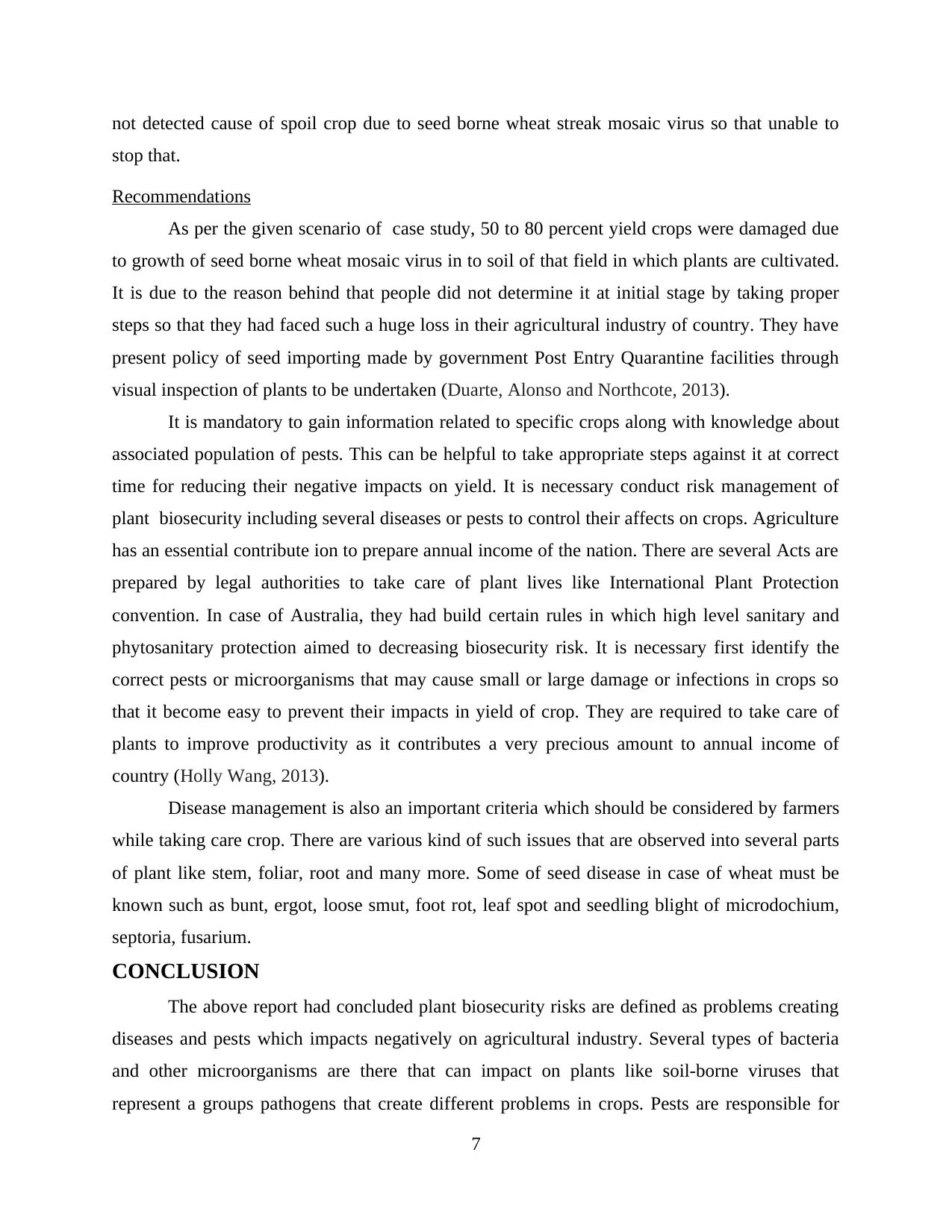
not detected cause of spoil crop due to seed borne wheat streak mosaic virus so that unable to
stop that.
Recommendations
As per the given scenario of case study, 50 to 80 percent yield crops were damaged due
to growth of seed borne wheat mosaic virus in to soil of that field in which plants are cultivated.
It is due to the reason behind that people did not determine it at initial stage by taking proper
steps so that they had faced such a huge loss in their agricultural industry of country. They have
present policy of seed importing made by government Post Entry Quarantine facilities through
visual inspection of plants to be undertaken (Duarte, Alonso and Northcote, 2013).
It is mandatory to gain information related to specific crops along with knowledge about
associated population of pests. This can be helpful to take appropriate steps against it at correct
time for reducing their negative impacts on yield. It is necessary conduct risk management of
plant biosecurity including several diseases or pests to control their affects on crops. Agriculture
has an essential contribute ion to prepare annual income of the nation. There are several Acts are
prepared by legal authorities to take care of plant lives like International Plant Protection
convention. In case of Australia, they had build certain rules in which high level sanitary and
phytosanitary protection aimed to decreasing biosecurity risk. It is necessary first identify the
correct pests or microorganisms that may cause small or large damage or infections in crops so
that it become easy to prevent their impacts in yield of crop. They are required to take care of
plants to improve productivity as it contributes a very precious amount to annual income of
country (Holly Wang, 2013).
Disease management is also an important criteria which should be considered by farmers
while taking care crop. There are various kind of such issues that are observed into several parts
of plant like stem, foliar, root and many more. Some of seed disease in case of wheat must be
known such as bunt, ergot, loose smut, foot rot, leaf spot and seedling blight of microdochium,
septoria, fusarium.
CONCLUSION
The above report had concluded plant biosecurity risks are defined as problems creating
diseases and pests which impacts negatively on agricultural industry. Several types of bacteria
and other microorganisms are there that can impact on plants like soil-borne viruses that
represent a groups pathogens that create different problems in crops. Pests are responsible for
7
stop that.
Recommendations
As per the given scenario of case study, 50 to 80 percent yield crops were damaged due
to growth of seed borne wheat mosaic virus in to soil of that field in which plants are cultivated.
It is due to the reason behind that people did not determine it at initial stage by taking proper
steps so that they had faced such a huge loss in their agricultural industry of country. They have
present policy of seed importing made by government Post Entry Quarantine facilities through
visual inspection of plants to be undertaken (Duarte, Alonso and Northcote, 2013).
It is mandatory to gain information related to specific crops along with knowledge about
associated population of pests. This can be helpful to take appropriate steps against it at correct
time for reducing their negative impacts on yield. It is necessary conduct risk management of
plant biosecurity including several diseases or pests to control their affects on crops. Agriculture
has an essential contribute ion to prepare annual income of the nation. There are several Acts are
prepared by legal authorities to take care of plant lives like International Plant Protection
convention. In case of Australia, they had build certain rules in which high level sanitary and
phytosanitary protection aimed to decreasing biosecurity risk. It is necessary first identify the
correct pests or microorganisms that may cause small or large damage or infections in crops so
that it become easy to prevent their impacts in yield of crop. They are required to take care of
plants to improve productivity as it contributes a very precious amount to annual income of
country (Holly Wang, 2013).
Disease management is also an important criteria which should be considered by farmers
while taking care crop. There are various kind of such issues that are observed into several parts
of plant like stem, foliar, root and many more. Some of seed disease in case of wheat must be
known such as bunt, ergot, loose smut, foot rot, leaf spot and seedling blight of microdochium,
septoria, fusarium.
CONCLUSION
The above report had concluded plant biosecurity risks are defined as problems creating
diseases and pests which impacts negatively on agricultural industry. Several types of bacteria
and other microorganisms are there that can impact on plants like soil-borne viruses that
represent a groups pathogens that create different problems in crops. Pests are responsible for
7

carrying specific bacteria from one place to another and then it spreads into soil of that field. It is
necessary conduct risk management of plant biosecurity including several diseases or pests to
control their affects on crops. Reducing risk of plant security in case of wheat crop cultivation to
get rid off yield loss.
8
necessary conduct risk management of plant biosecurity including several diseases or pests to
control their affects on crops. Reducing risk of plant security in case of wheat crop cultivation to
get rid off yield loss.
8
Secure Best Marks with AI Grader
Need help grading? Try our AI Grader for instant feedback on your assignments.
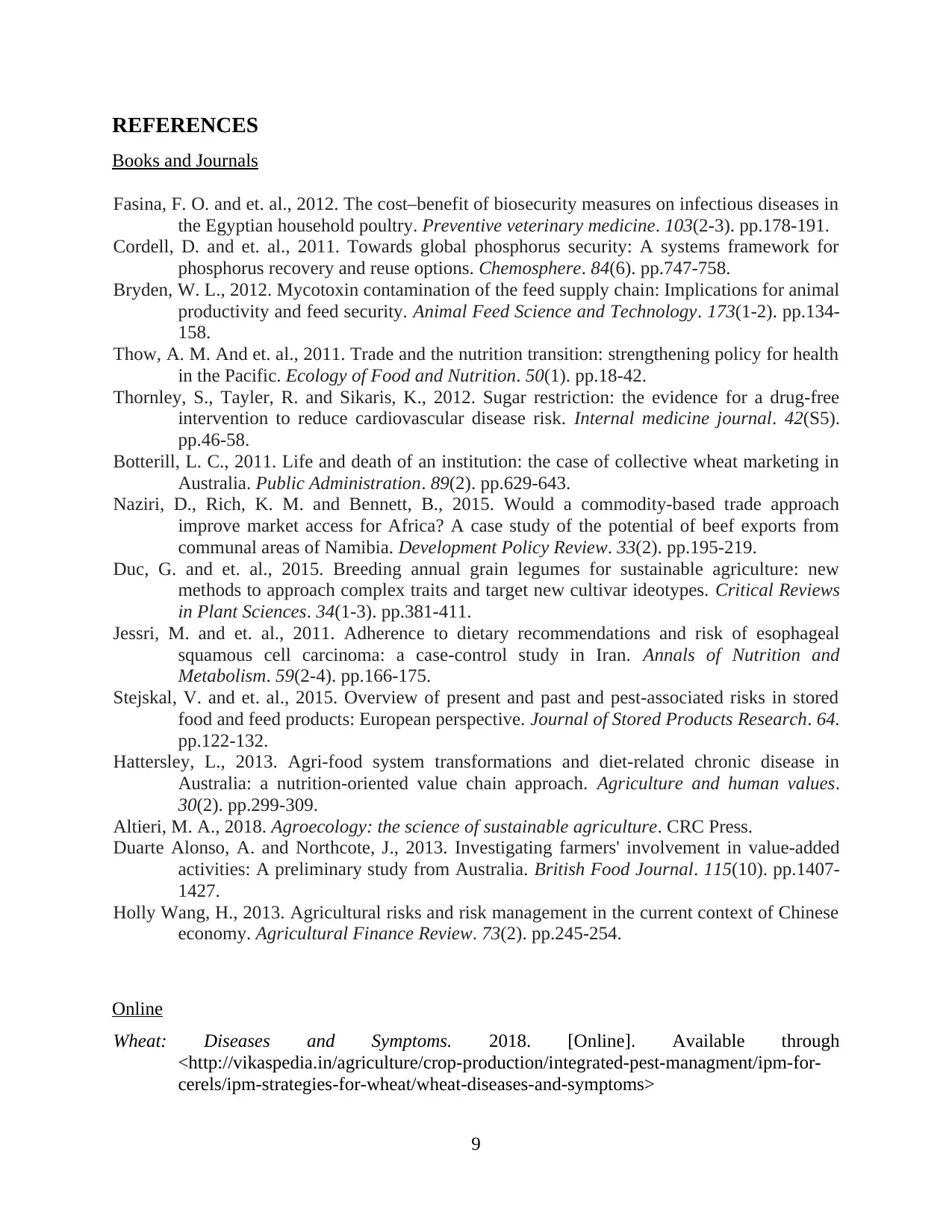
REFERENCES
Books and Journals
Fasina, F. O. and et. al., 2012. The cost–benefit of biosecurity measures on infectious diseases in
the Egyptian household poultry. Preventive veterinary medicine. 103(2-3). pp.178-191.
Cordell, D. and et. al., 2011. Towards global phosphorus security: A systems framework for
phosphorus recovery and reuse options. Chemosphere. 84(6). pp.747-758.
Bryden, W. L., 2012. Mycotoxin contamination of the feed supply chain: Implications for animal
productivity and feed security. Animal Feed Science and Technology. 173(1-2). pp.134-
158.
Thow, A. M. And et. al., 2011. Trade and the nutrition transition: strengthening policy for health
in the Pacific. Ecology of Food and Nutrition. 50(1). pp.18-42.
Thornley, S., Tayler, R. and Sikaris, K., 2012. Sugar restriction: the evidence for a drug‐free
intervention to reduce cardiovascular disease risk. Internal medicine journal. 42(S5).
pp.46-58.
Botterill, L. C., 2011. Life and death of an institution: the case of collective wheat marketing in
Australia. Public Administration. 89(2). pp.629-643.
Naziri, D., Rich, K. M. and Bennett, B., 2015. Would a commodity‐based trade approach
improve market access for Africa? A case study of the potential of beef exports from
communal areas of Namibia. Development Policy Review. 33(2). pp.195-219.
Duc, G. and et. al., 2015. Breeding annual grain legumes for sustainable agriculture: new
methods to approach complex traits and target new cultivar ideotypes. Critical Reviews
in Plant Sciences. 34(1-3). pp.381-411.
Jessri, M. and et. al., 2011. Adherence to dietary recommendations and risk of esophageal
squamous cell carcinoma: a case-control study in Iran. Annals of Nutrition and
Metabolism. 59(2-4). pp.166-175.
Stejskal, V. and et. al., 2015. Overview of present and past and pest-associated risks in stored
food and feed products: European perspective. Journal of Stored Products Research. 64.
pp.122-132.
Hattersley, L., 2013. Agri-food system transformations and diet-related chronic disease in
Australia: a nutrition-oriented value chain approach. Agriculture and human values.
30(2). pp.299-309.
Altieri, M. A., 2018. Agroecology: the science of sustainable agriculture. CRC Press.
Duarte Alonso, A. and Northcote, J., 2013. Investigating farmers' involvement in value-added
activities: A preliminary study from Australia. British Food Journal. 115(10). pp.1407-
1427.
Holly Wang, H., 2013. Agricultural risks and risk management in the current context of Chinese
economy. Agricultural Finance Review. 73(2). pp.245-254.
Online
Wheat: Diseases and Symptoms. 2018. [Online]. Available through
<http://vikaspedia.in/agriculture/crop-production/integrated-pest-managment/ipm-for-
cerels/ipm-strategies-for-wheat/wheat-diseases-and-symptoms>
9
Books and Journals
Fasina, F. O. and et. al., 2012. The cost–benefit of biosecurity measures on infectious diseases in
the Egyptian household poultry. Preventive veterinary medicine. 103(2-3). pp.178-191.
Cordell, D. and et. al., 2011. Towards global phosphorus security: A systems framework for
phosphorus recovery and reuse options. Chemosphere. 84(6). pp.747-758.
Bryden, W. L., 2012. Mycotoxin contamination of the feed supply chain: Implications for animal
productivity and feed security. Animal Feed Science and Technology. 173(1-2). pp.134-
158.
Thow, A. M. And et. al., 2011. Trade and the nutrition transition: strengthening policy for health
in the Pacific. Ecology of Food and Nutrition. 50(1). pp.18-42.
Thornley, S., Tayler, R. and Sikaris, K., 2012. Sugar restriction: the evidence for a drug‐free
intervention to reduce cardiovascular disease risk. Internal medicine journal. 42(S5).
pp.46-58.
Botterill, L. C., 2011. Life and death of an institution: the case of collective wheat marketing in
Australia. Public Administration. 89(2). pp.629-643.
Naziri, D., Rich, K. M. and Bennett, B., 2015. Would a commodity‐based trade approach
improve market access for Africa? A case study of the potential of beef exports from
communal areas of Namibia. Development Policy Review. 33(2). pp.195-219.
Duc, G. and et. al., 2015. Breeding annual grain legumes for sustainable agriculture: new
methods to approach complex traits and target new cultivar ideotypes. Critical Reviews
in Plant Sciences. 34(1-3). pp.381-411.
Jessri, M. and et. al., 2011. Adherence to dietary recommendations and risk of esophageal
squamous cell carcinoma: a case-control study in Iran. Annals of Nutrition and
Metabolism. 59(2-4). pp.166-175.
Stejskal, V. and et. al., 2015. Overview of present and past and pest-associated risks in stored
food and feed products: European perspective. Journal of Stored Products Research. 64.
pp.122-132.
Hattersley, L., 2013. Agri-food system transformations and diet-related chronic disease in
Australia: a nutrition-oriented value chain approach. Agriculture and human values.
30(2). pp.299-309.
Altieri, M. A., 2018. Agroecology: the science of sustainable agriculture. CRC Press.
Duarte Alonso, A. and Northcote, J., 2013. Investigating farmers' involvement in value-added
activities: A preliminary study from Australia. British Food Journal. 115(10). pp.1407-
1427.
Holly Wang, H., 2013. Agricultural risks and risk management in the current context of Chinese
economy. Agricultural Finance Review. 73(2). pp.245-254.
Online
Wheat: Diseases and Symptoms. 2018. [Online]. Available through
<http://vikaspedia.in/agriculture/crop-production/integrated-pest-managment/ipm-for-
cerels/ipm-strategies-for-wheat/wheat-diseases-and-symptoms>
9

10

11
Paraphrase This Document
Need a fresh take? Get an instant paraphrase of this document with our AI Paraphraser

1
1 out of 14
Your All-in-One AI-Powered Toolkit for Academic Success.
+13062052269
info@desklib.com
Available 24*7 on WhatsApp / Email
![[object Object]](/_next/static/media/star-bottom.7253800d.svg)
Unlock your academic potential
© 2024 | Zucol Services PVT LTD | All rights reserved.